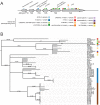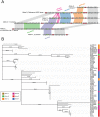Drivers of genetic diversity in secondary metabolic gene clusters within a fungal species
- PMID: 29149178
- PMCID: PMC5711037
- DOI: 10.1371/journal.pbio.2003583
Drivers of genetic diversity in secondary metabolic gene clusters within a fungal species
Abstract
Filamentous fungi produce a diverse array of secondary metabolites (SMs) critical for defense, virulence, and communication. The metabolic pathways that produce SMs are found in contiguous gene clusters in fungal genomes, an atypical arrangement for metabolic pathways in other eukaryotes. Comparative studies of filamentous fungal species have shown that SM gene clusters are often either highly divergent or uniquely present in one or a handful of species, hampering efforts to determine the genetic basis and evolutionary drivers of SM gene cluster divergence. Here, we examined SM variation in 66 cosmopolitan strains of a single species, the opportunistic human pathogen Aspergillus fumigatus. Investigation of genome-wide within-species variation revealed 5 general types of variation in SM gene clusters: nonfunctional gene polymorphisms; gene gain and loss polymorphisms; whole cluster gain and loss polymorphisms; allelic polymorphisms, in which different alleles corresponded to distinct, nonhomologous clusters; and location polymorphisms, in which a cluster was found to differ in its genomic location across strains. These polymorphisms affect the function of representative A. fumigatus SM gene clusters, such as those involved in the production of gliotoxin, fumigaclavine, and helvolic acid as well as the function of clusters with undefined products. In addition to enabling the identification of polymorphisms, the detection of which requires extensive genome-wide synteny conservation (e.g., mobile gene clusters and nonhomologous cluster alleles), our approach also implicated multiple underlying genetic drivers, including point mutations, recombination, and genomic deletion and insertion events as well as horizontal gene transfer from distant fungi. Finally, most of the variants that we uncover within A. fumigatus have been previously hypothesized to contribute to SM gene cluster diversity across entire fungal classes and phyla. We suggest that the drivers of genetic diversity operating within a fungal species shown here are sufficient to explain SM cluster macroevolutionary patterns.
Conflict of interest statement
The authors have declared that no competing interests exist.
Figures






Similar articles
-
Gliotoxin, a Known Virulence Factor in the Major Human Pathogen Aspergillus fumigatus, Is Also Biosynthesized by Its Nonpathogenic Relative Aspergillus fischeri.mBio. 2020 Feb 11;11(1):e03361-19. doi: 10.1128/mBio.03361-19. mBio. 2020. PMID: 32047138 Free PMC article.
-
Beyond the Biosynthetic Gene Cluster Paradigm: Genome-Wide Coexpression Networks Connect Clustered and Unclustered Transcription Factors to Secondary Metabolic Pathways.Microbiol Spectr. 2021 Oct 31;9(2):e0089821. doi: 10.1128/Spectrum.00898-21. Epub 2021 Sep 15. Microbiol Spectr. 2021. PMID: 34523946 Free PMC article.
-
Diversity of Secondary Metabolism in Aspergillus nidulans Clinical Isolates.mSphere. 2020 Apr 8;5(2):e00156-20. doi: 10.1128/mSphere.00156-20. mSphere. 2020. PMID: 32269157 Free PMC article.
-
Strategies to establish the link between biosynthetic gene clusters and secondary metabolites.Fungal Genet Biol. 2019 Sep;130:107-121. doi: 10.1016/j.fgb.2019.06.001. Epub 2019 Jun 10. Fungal Genet Biol. 2019. PMID: 31195124 Review.
-
Harnessing diverse transcriptional regulators for natural product discovery in fungi.Nat Prod Rep. 2020 Jan 29;37(1):6-16. doi: 10.1039/c8np00027a. Nat Prod Rep. 2020. PMID: 31033969 Review.
Cited by
-
Unraveling the genomic diversity and virulence of human fungal pathogens through pangenomics.PLoS Pathog. 2024 Jul 11;20(7):e1012313. doi: 10.1371/journal.ppat.1012313. eCollection 2024 Jul. PLoS Pathog. 2024. PMID: 38990800 Free PMC article. No abstract available.
-
Genomic and Phenotypic Analysis of COVID-19-Associated Pulmonary Aspergillosis Isolates of Aspergillus fumigatus.Microbiol Spectr. 2021 Sep 3;9(1):e0001021. doi: 10.1128/Spectrum.00010-21. Epub 2021 Jun 9. Microbiol Spectr. 2021. PMID: 34106569 Free PMC article.
-
Global Analysis of Natural Products Biosynthetic Diversity Encoded in Fungal Genomes.J Fungi (Basel). 2024 Sep 13;10(9):653. doi: 10.3390/jof10090653. J Fungi (Basel). 2024. PMID: 39330413 Free PMC article.
-
Microevolution in the pansecondary metabolome of Aspergillus flavus and its potential macroevolutionary implications for filamentous fungi.Proc Natl Acad Sci U S A. 2021 May 25;118(21):e2021683118. doi: 10.1073/pnas.2021683118. Proc Natl Acad Sci U S A. 2021. PMID: 34016748 Free PMC article.
-
Transcriptional Control of the Production of Aspergillus fumigatus Conidia-Borne Secondary Metabolite Fumiquinazoline C Important for Phagocytosis Protection.Genetics. 2021 May 17;218(1):iyab036. doi: 10.1093/genetics/iyab036. Genetics. 2021. PMID: 33705521 Free PMC article.
References
-
- Vining LC. Functions of secondary metabolites. Annu Rev Microbiol. Annual Reviews 4139 El Camino Way, P.O. Box 10139, Palo Alto, CA 94303–0139, USA; 1990;44: 395–427. doi: 10.1146/annurev.mi.44.100190.002143 - DOI - PubMed
-
- Schimek C. Evolution of Special Metabolism in Fungi: Concepts, Mechanisms, and Pathways In: Pöggler S, Wöstmeyer J, editors. Evolution of Fungi and Fungal-Like Organisms, The Mycota. XIV Berlin, Heidelberg: Springer-Verlag; 2011. pp. 293–328.
-
- Fox EM, Howlett BJ. Secondary metabolism: regulation and role in fungal biology. Curr Opin Microbiol. 2008;11: 481–7. doi: 10.1016/j.mib.2008.10.007 - DOI - PubMed
-
- Scharf DH, Heinekamp T, Brakhage AA. Human and Plant Fungal Pathogens: The Role of Secondary Metabolites. PLoS Pathog. 2014;10(1): e1003859 doi: 10.1371/journal.ppat.1003859 - DOI - PMC - PubMed
-
- Yim G, Wang HH, Davies J. Antibiotics as signalling molecules. Philos Trans R Soc Lond B Biol Sci. 2007;362: 1195–200. doi: 10.1098/rstb.2007.2044 - DOI - PMC - PubMed
MeSH terms
Substances
Grants and funding
LinkOut - more resources
Full Text Sources
Other Literature Sources

